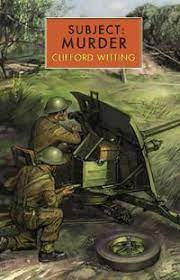Last week I kicked off the 2023 Reprint of the Year award. If you missed that post, here is a link. It explains what the award is about and includes all the key dates for voting, as well as providing readers with the chance to make their own nominations. Three of these nominations will make it into the final poll.
Before you find out my first candidate, here are the links for the other nominations given by bloggers this week:
Bev – The Big Sleep (1939) by Raymond Chandler
Brad – The Case of the Rolling Bones (1939) by Erle Stanley Gardner
Hayley – In a Lonely Place (1947) by Dorothy B. Hughes
Janet – Death of Mr Dodsley (1937) by John Ferguson
John – Game Without Rules (1962) by Michael Gilbert
Karen – Crimes of Cymru (2023) ed.by Martin Edwards
Moira – At the Sign of the Clove and Hoof (1937) by Zoë Johnson
Puzzle Doctor – He Who Whispers (1946) by John Dickson Carr
Rick – The Great Mistake (1940) by Mary Roberts Rinehart
Due to the number of excellent reprints that I have read this year, narrowing my choices down to two was difficult. However, one title which I was immediately drawn to was Subject: Murder (1945) by Clifford Witting, the 6th Inspector Charlton mystery. 2023 has been a good year for Witting as three of his mysteries have been reprinted, the other two being: Let X Be the Murderer (1947) and The Case of the Michaelmas Goose (1938). Before I provide a whistlestop tour of the reasons why Subject: Murder deserves your vote, here is a quick summary of what it is about:
‘The dispatch of Battery-Sergeant-major William George “Cruel” Yule had elicited few tears, as odious and manipulative to the last, he’d made life hell for those he oversaw, especially ones who’d crossed him. But who out of many, had actually bumped off the Sergeant-major? Scotland Yard must find out who-did-him-in. Inspector Charlton takes the lead, aided by narrator of this tale and former bloodhound of the law, Peter Bradfield, now a bombardier in a Light Anti-Aircraft Battery. Their interrogation of the assembled army personnel uncovers dark and unsavoury deeds, tyrannical behaviour and shenanigans […] There is a plentiful supply of clues and red herrings in this fascinating first-rate detective story which also depicts the trials, tribulations and ugliness of WWII army life.’
The synopsis above heralds some of the reasons why this is such great read, the first being…
Reason No. 1: Has Witting created the most unpleasant victim of the classic crime era?
The unlikeable murder victim is a familiar trope and back in 2016 I even wrote a post about Agatha Christie’s most memorable victims. However, when I read Subject: Murder earlier this year, I wondered if Mrs Boynton (from Appointment with Death) had met her match. One of the reasons for thinking this was because Witting’s victim, Sergeant-Major Yule, due to his military position, has a much bigger range of people whose lives he can make miserable and because of his job, he has better means for doing so and getting away with it. What makes his cruelty worse is ‘that his was not the straightforward brutality, the healthy gall of the Army bull. It was more of the cat-and-mouse type. He liked to see others in pain or distress, particularly if he himself had been the agent of their sufferings.’ This is no case of a rich patriarch cutting off someone’s allowance. Sergeant Yule’s horrible nature and behaviours, perhaps due to the wartime military setting, is allowed to go that little bit darker. But speaking of setting that brings us on to reason number two…
Reason No. 2: Witting’s realistic setting.
As you might have picked up from the post so far, the setting of Subject: Murder is a unit of the Light Anti-Aircraft Battery, which is operating during WW2. In my opinion Witting does an excellent job of bringing this quite niche setting to life and describing it so readers not familiar with it, can build up a picture of what it is like. It is not surprising that he does this so well, because the setting is based upon his own wartime experiences, being a part of such a unit himself. I think settings rooted in author experiences tend to come to life more on the page because they know what details to include and what anecdotes to weave in, without it sounding like a textbook explanation. Fellow blogger, Tom Cat who writes at Beneath the Stains of Time, also enjoyed this element of the book saying in his review that he ‘loved the detailed, now historical, military background’ and he concludes at the end of his review that he ‘would place Witting’s Subject—Murder among the ten, or so, best World War II-era detective novels that comes highly recommend.’ In addition, Witting does not just use his setting as a mere backdrop to his murder mystery. Instead, he weaves crucial details concerning the solution into the setting and setup. This is a mystery where you need to keep your eyes peeled! John Norris who writes at the blog Pretty Sinister Books voiced a similar idea back in 2013 when he wrote that: ‘The detection in this book is top-notch. Clues and red herrings are abundant as in any of the best examples of the fair play detective novel.’ And I would add that the setting of the story is a key part of how the clues and red herrings work so well.
Reason No. 3: Witting knows how to keep us waiting.
Whilst many a detective story unfurls their corpse in the first few chapters or even pages, others have preferred to delay the arrival of the dead body. Both methods have their pros and cons. The latter approach has the benefit of allowing the reader to become familiar with the setting and the potential suspects, as well as the intended victim, before the murder occurs. However, maintaining reader interest can be hard and there is a risk of the reader becoming bored before the murderer strikes. But this is not the case with Clifford Witting in this story. Firstly, the vivid setting engages the reader, and you are happy to be immersed in that world. Furthermore, the delay in Yule being murdered, means we get plenty of time to see his horribleness in action and consequently I think as a victim he is more developed and psychologically realistic.
Reason No. 4: It has a locked room, well hut, component!
This is more of a bonus reason, but I thought I would flag it up as it is not a well-known aspect of the story and I know how locked room mystery fans are always keen to find a new such mystery to read. Moreover, Tom Cat, who is a blogger with extensive knowledge of locked room mysteries, notes in his review that the solution to the locked hut is ‘a good and original one.’
Over to You!
Which of these week’s nominations have you read and enjoyed? Are there any other fans out there for Witting’s Subject: Murder?
Come back next week to see the second round of nominations!


I would put this right up there with Brand’s latest as one of my favorite reprints of the year. The attention to detail in the setting is definitely one of the biggest pluses for me but I enjoy his series characters as well. Yes, the victim is one nasty dude!
LikeLiked by 1 person
Yes the setting plays a key part in this book’s success. Rather like Michael Gilbert’s The Danger Within a.k.a. Death in Captivity.
LikeLike
Exactly the comparison I had in mind (except I couldn’t remember the title!)…that was a brilliant use of setting!
LikeLike
Among the ten nominations, the clear favourite is HE WHO WHISPERS !
LikeLiked by 1 person
True, but clear favourites have not always won.
LikeLike
Several books for the TBR in this first round! Looking forward to everyone’s choices in Week 2.
LikeLiked by 1 person
Yes the ROYs can be a bit perilous for ones TBR pile. Which ones caught your attention?
LikeLike
The Gardner (I’ve only started reading him since AMC has been reprinting), the Hughes (I am so interested to experience how different it is from the Bogart movie) and the Johnson (something completely new and different). I love how the nominations run the spectrum of famous, well-known (and yet somehow just coming back in print) and the obscure as well as all types of crime/detective novels. Something for everyone to add to the mountain of books waiting their turn 😃.
LikeLiked by 1 person
Yes the variety of nominations is always something that pleases me too. But I like to think it reflects how varied classic crime could be.
LikeLike
[…] nominations for the 2023 Reprint of the Year Award. If you missed those posts here is a link to my own, which contains links to all the other […]
LikeLike
[…] you haven’t made your mind up on which titles to vote for, then check out my Nomination 1 and Nomination 2 posts, as they also include links to all the blogger chosen […]
LikeLike